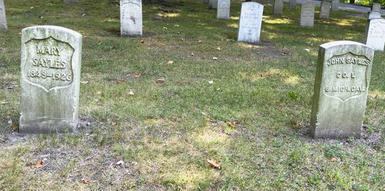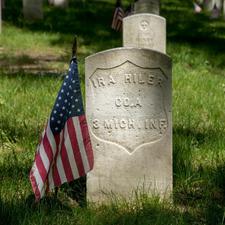The Grand Rapids Civil War Round Table welcomes the return of Steve Soper and his presentation, "The Soldiers of the Old 3rd (and Several Wives) Buried in the Michigan Soldiers’ Home Cemetery". More than 100 former members of the Old 3rd Michigan Infantry lived at one time or another in the Michigan Soldiers Home. Forty-four of those men along with at least 11 wives are buried in the Home Cemetery. Following a short history of the Soldiers’ Home in Grand Rapids, today one of three Michigan Veterans Homes, I hope to share just a few life stories of men and a few women who ended their days in the Home.
Steve Soper has spent more than 30 years researching the 3rd Michigan Infantry 1st organization and the lives of the regiment’s 1,411 soldiers. For more information you can find Steve’s history of the Old 3rd as well as his four volumes of biographical sketches in the Local Collections room at the Grand Rapids Public Library.
Major General Benjamin Butler's men were not treated well at the start of the Union occupation of New Orleans. The city's female population spoke horribly at the men. They also spit on them and dumped their chamber pots out of their windows on to the soldiers below. Butler was concerned about the morale of the men and issued General Order No. 28. "any female shall by word, gesture, or movement insult or show contempt for any officer or soldier of the United States shall be regarded and held liable to be treated as a woman of the town plying her avocation."
Hostilities Commenced!
FORT SUMTER BOMBARDED!
The Rebels Strike the First Blow!
MOULTRIE OPENS ON MAJ. ANDERSON!
SEVEN OF THEIR BATTERIES FOLLOW!
Prompt Response from Sumter!
Fighting Commenced at four O'Clock Yesterday
Morning and Continued all Day!
The Harriet Lane Reported in the Offing!
No Other Vessels in Sight!
SEVERAL OF MAJ ANDERSON'S GUNS SILENCED!
The Fort to be Stormed!
~ Milwaukee Sentinel
April 13, 1861
Reported from New York, April 9, 1861: Wall Street is as blue as blazes today; confidence seems clear gone, for no one can tell what an hour may bring forth. The street itself has not one quarter the bustle usually observable during business hours, and at one time it appears more like a holiday than a moment for dollars and exchange, cotton and real estate. Indeed, I cannot call to mind a day when there was such an utter feeling of despondency and want of confidence as is perceptible at this hour.
~ New Orleans Daily Picayune
April 17, 1861
Winfield Scott was known as "Old Fuss and Feathers" for his insistence on appearance and detail among his troops. He was also know as the "Grand Old Man of the Army," having served as a general longer than any other man in American History. He commanded troops in the War of 1812, the Mexican-American War, the Black Hawk War, and the Second Seminole War before the Civil war.
Membership fees for the 2025-2026 season are $30.00.
Checks can be made out to GRCWRT.
Get your membership/renewal form on our website
membership page or at one of our meetings.
Dues are based on the meeting year, September - June.
We are always looking for new speakers. If you would like to give a presentation to the GRCWRT, or can recommend someone, please contact our program director.
Wednesday
November 19, 2025
Steve Soper
The Soldiers of the Old 3rd
(and Several Wives)
Buried in the Cemetery of
The Michigan Soldiers’ Home
We Meet At:
Orchard View Church of God
2777 Leffingwell Ave. NE
Grand Rapids, Michigan
Located at the southwest corner of
3 Mile Road NE and Leffingwell Avenue NE
Doors open at 6:30 p.m.
Program begins at 7:00 pm
Civil War Notes
Our Next Meeting
Special Announcements:
The Graves of John and Mary Sayles
and The Grave of Ira Hiler at
The Michigan Soldier's Home Cemetery



